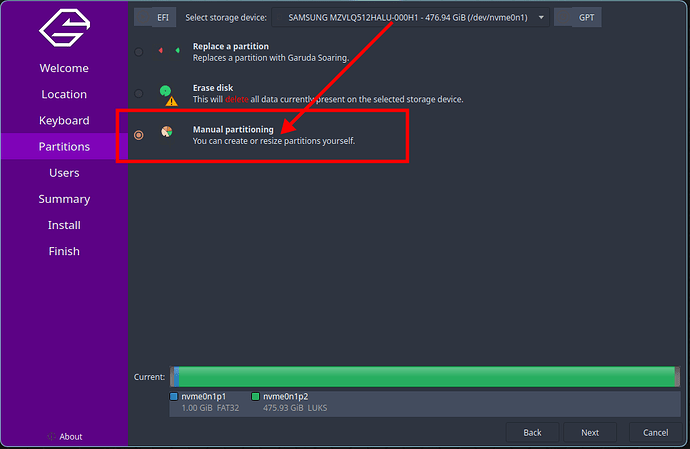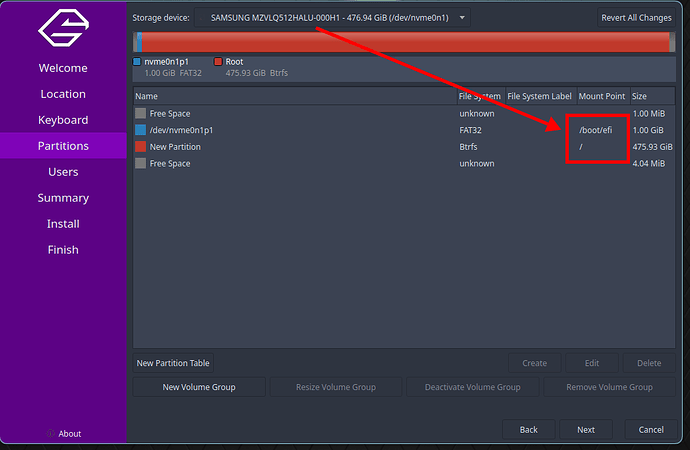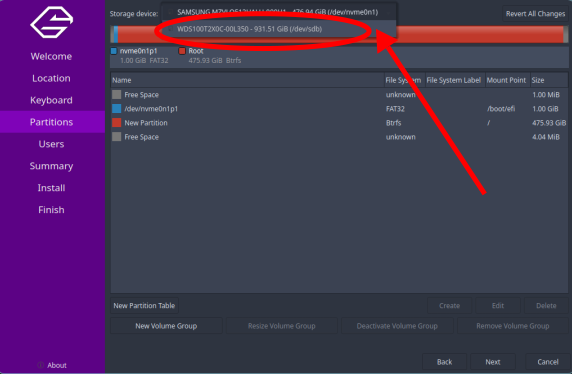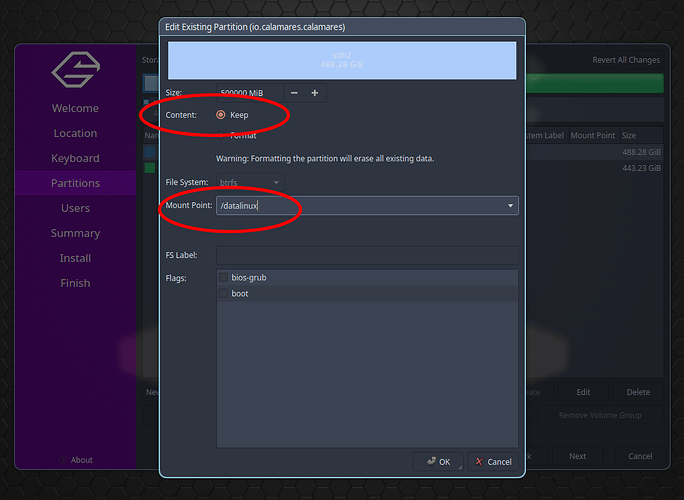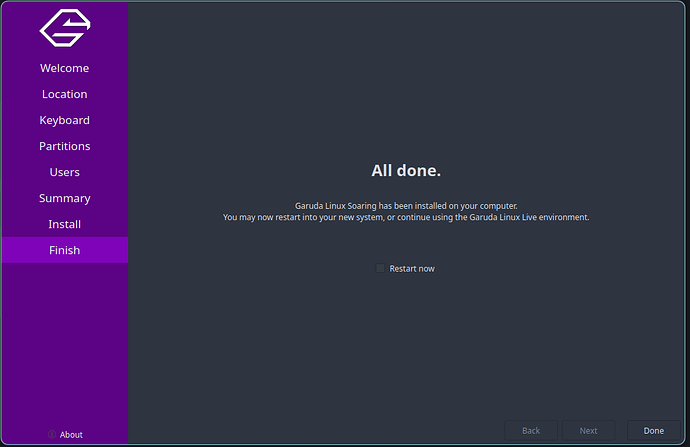Hey all,
Here’s my inxi
System:
Kernel: 6.9.5-zen1-1-zen arch: x86_64 bits: 64 compiler: gcc v: 14.1.1
clocksource: tsc avail: hpet,acpi_pm
parameters: BOOT_IMAGE=/@/boot/vmlinuz-linux-zen
root=UUID=67e1e13a-4842-4384-b3eb-3f6fa6d905be rw rootflags=subvol=@
quiet rd.udev.log_priority=3 vt.global_cursor_default=0 loglevel=3 splash
pcie_aspm=off ibt=off
Desktop: KDE Plasma v: 6.0.5 tk: Qt v: N/A info: frameworks v: 6.3.0
wm: kwin_x11 vt: 2 dm: SDDM Distro: Garuda base: Arch Linux
Machine:
Type: Laptop System: Acer product: Aspire A517-51 v: V2.03
serial: <superuser required>
Mobo: KBL model: Dragonite_KL v: V2.03 serial: <superuser required>
part-nu: 0000000000000000 uuid: <superuser required> UEFI: Insyde v: 2.03
date: 05/22/2019
Battery:
ID-1: BAT1 charge: 34.6 Wh (100.0%) condition: 34.6/48.9 Wh (70.8%)
volts: 16.2 min: 15.2 model: LG 004B384234314341 type: Li-ion
serial: <filter> status: full
CPU:
Info: model: Intel Core i5-8250U bits: 64 type: MT MCP arch: Coffee Lake
gen: core 8 level: v3 note: check built: 2017 process: Intel 14nm family: 6
model-id: 0x8E (142) stepping: 0xA (10) microcode: 0xF4
Topology: cpus: 1x cores: 4 tpc: 2 threads: 8 smt: enabled cache:
L1: 256 KiB desc: d-4x32 KiB; i-4x32 KiB L2: 1024 KiB desc: 4x256 KiB
L3: 6 MiB desc: 1x6 MiB
Speed (MHz): avg: 500 high: 800 min/max: 400/3400 scaling:
driver: intel_pstate governor: powersave cores: 1: 400 2: 800 3: 400 4: 400
5: 800 6: 400 7: 400 8: 400 bogomips: 28800
Flags: avx avx2 ht lm nx pae sse sse2 sse3 sse4_1 sse4_2 ssse3 vmx
Vulnerabilities: <filter>
Graphics:
Device-1: Intel UHD Graphics 620 vendor: Acer Incorporated ALI driver: i915
v: kernel arch: Gen-9.5 process: Intel 14nm built: 2016-20 ports:
active: eDP-1 empty: HDMI-A-1 bus-ID: 00:02.0 chip-ID: 8086:5917
class-ID: 0300
Device-2: Quanta HD Webcam driver: uvcvideo type: USB rev: 2.0
speed: 480 Mb/s lanes: 1 mode: 2.0 bus-ID: 1-7:4 chip-ID: 0408:a060
class-ID: 0e02 serial: <filter>
Display: x11 server: X.Org v: 21.1.13 with: Xwayland v: 24.1.0
compositor: kwin_x11 driver: X: loaded: modesetting
alternate: fbdev,intel,vesa dri: iris gpu: i915 display-ID: :0 screens: 1
Screen-1: 0 s-res: 1920x1080 s-dpi: 96 s-size: 508x285mm (20.00x11.22")
s-diag: 582mm (22.93")
Monitor-1: eDP-1 model: AU Optronics 0x139d built: 2017 res: 1920x1080
hz: 60 dpi: 128 gamma: 1.2 size: 381x214mm (15x8.43") diag: 437mm (17.2")
ratio: 16:9 modes: 1920x1080
API: EGL v: 1.5 hw: drv: intel iris platforms: device: 0 drv: iris
device: 1 drv: swrast surfaceless: drv: iris x11: drv: iris
inactive: gbm,wayland
API: OpenGL v: 4.6 compat-v: 4.5 vendor: intel mesa v: 24.1.1-arch1.1
glx-v: 1.4 direct-render: yes renderer: Mesa Intel UHD Graphics 620 (KBL
GT2) device-ID: 8086:5917 memory: 3.73 GiB unified: yes
API: Vulkan v: 1.3.279 layers: 3 device: 0 type: integrated-gpu name: Intel
UHD Graphics 620 (KBL GT2) driver: mesa intel v: 24.1.1-arch1.1
device-ID: 8086:5917 surfaces: xcb,xlib device: 1 type: cpu name: llvmpipe
(LLVM 17.0.6 256 bits) driver: mesa llvmpipe v: 24.1.1-arch1.1 (LLVM
17.0.6) device-ID: 10005:0000 surfaces: xcb,xlib
Audio:
Device-1: Intel Sunrise Point-LP HD Audio vendor: Acer Incorporated ALI
driver: snd_hda_intel v: kernel alternate: snd_soc_skl,snd_soc_avs
bus-ID: 00:1f.3 chip-ID: 8086:9d71 class-ID: 0403
API: ALSA v: k6.9.5-zen1-1-zen status: kernel-api tools: N/A
Server-1: PipeWire v: 1.0.7 status: active with: 1: pipewire-pulse
status: active 2: wireplumber status: active 3: pw-jack type: plugin
tools: pactl,pw-cat,pw-cli,wpctl
Network:
Device-1: Realtek RTL8111/8168/8211/8411 PCI Express Gigabit Ethernet
vendor: Acer Incorporated ALI driver: r8169 v: kernel pcie: gen: 1
speed: 2.5 GT/s lanes: 1 port: 3000 bus-ID: 01:00.1 chip-ID: 10ec:8168
class-ID: 0200
IF: enp1s0f1 state: up speed: 1000 Mbps duplex: full mac: <filter>
Device-2: Qualcomm Atheros QCA9377 802.11ac Wireless Network Adapter
vendor: Lite-On driver: ath10k_pci v: kernel pcie: gen: 1 speed: 2.5 GT/s
lanes: 1 bus-ID: 02:00.0 chip-ID: 168c:0042 class-ID: 0280
IF: wlp2s0 state: down mac: <filter>
Info: services: NetworkManager
Bluetooth:
Device-1: Lite-On Qualcomm Atheros QCA9377 Bluetooth driver: btusb v: 0.8
type: USB rev: 2.0 speed: 12 Mb/s lanes: 1 mode: 1.1 bus-ID: 1-5:3
chip-ID: 04ca:3015 class-ID: e001
Report: btmgmt ID: hci0 rfk-id: 2 state: up address: <filter> bt-v: 4.2
lmp-v: 8 status: discoverable: no pairing: no class-ID: 6c010c
Drives:
Local Storage: total: 1.14 TiB used: 258.97 GiB (22.1%)
SMART Message: Unable to run smartctl. Root privileges required.
ID-1: /dev/sda maj-min: 8:0 vendor: Toshiba model: MQ04ABF100
size: 931.51 GiB block-size: physical: 4096 B logical: 512 B speed: 6.0 Gb/s
tech: HDD rpm: 5400 serial: <filter> fw-rev: 1J
ID-2: /dev/sdb maj-min: 8:16 vendor: SanDisk model: SD9SN8W256G1014
size: 238.47 GiB block-size: physical: 512 B logical: 512 B speed: 6.0 Gb/s
tech: SSD serial: <filter> fw-rev: 7000 scheme: GPT
Partition:
ID-1: / raw-size: 118.93 GiB size: 118.93 GiB (100.00%)
used: 94.34 GiB (79.3%) fs: btrfs dev: /dev/sdb8 maj-min: 8:24
ID-2: /boot/efi raw-size: 547 MiB size: 545.9 MiB (99.80%)
used: 584 KiB (0.1%) fs: vfat dev: /dev/sdb6 maj-min: 8:22
ID-3: /home raw-size: 118.93 GiB size: 118.93 GiB (100.00%)
used: 94.34 GiB (79.3%) fs: btrfs dev: /dev/sdb8 maj-min: 8:24
ID-4: /var/log raw-size: 118.93 GiB size: 118.93 GiB (100.00%)
used: 94.34 GiB (79.3%) fs: btrfs dev: /dev/sdb8 maj-min: 8:24
ID-5: /var/tmp raw-size: 118.93 GiB size: 118.93 GiB (100.00%)
used: 94.34 GiB (79.3%) fs: btrfs dev: /dev/sdb8 maj-min: 8:24
Swap:
Kernel: swappiness: 133 (default 60) cache-pressure: 100 (default) zswap: no
ID-1: swap-1 type: zram size: 7.63 GiB used: 176.5 MiB (2.3%)
priority: 100 comp: zstd avail: lzo,lzo-rle,lz4,lz4hc,842 max-streams: 8
dev: /dev/zram0
Sensors:
System Temperatures: cpu: 49.0 C mobo: N/A
Fan Speeds (rpm): N/A
Info:
Memory: total: 8 GiB available: 7.63 GiB used: 2.75 GiB (36.0%)
Processes: 254 Power: uptime: 26m states: freeze,mem,disk suspend: deep
avail: s2idle wakeups: 0 hibernate: platform avail: shutdown, reboot,
suspend, test_resume image: 3.01 GiB services: org_kde_powerdevil,
power-profiles-daemon, upowerd Init: systemd v: 256 default: graphical
tool: systemctl
Packages: pm: pacman pkgs: 1540 libs: 447 tools: octopi,pamac,paru,yay
Compilers: clang: 17.0.6 gcc: 14.1.1 Shell: garuda-inxi default: fish
v: 3.7.1 running-in: konsole inxi: 3.3.34
Garuda (2.6.26-1):
System install date: 2023-09-12
Last full system update: 2024-06-19
Is partially upgraded: No
Relevant software: snapper NetworkManager mkinitcpio
Windows dual boot: Probably (Run as root to verify)
Failed units:
I have decided to reinstall Garuda with the latest iso (garuda-dr460nized-linux-zen-240428.iso). But during the install, when doing partitioning, i can see my sdb disk with the / and the /boot/efi partitions.
But i cant see de the sda disk containing my data. So i cant mount sda2.
It’s strange because in the live session Gparted can see the sda disk and the two partitions.
[root@jacques-aspirea51751 jacques]# parted -l
Model: ATA TOSHIBA MQ04ABF1 (scsi)
Disk /dev/sda: 1000GB
Sector size (logical/physical): 512B/4096B
Partition table: gpt
Disk flags :
Number Start End Size File system Name Flags
1 1049kB 490GB 490GB ntfs msftdata
2 490GB 1000GB 510GB ext4
Model: ATA SanDisk SD9SN8W2 (scsi)
Disk /dev/sdb: 256GB
Sector size (logical/physical): 512B/512B
Partition table: gpt
Disk flags :
Number Start End Size File system Name Flags
1 1049kB 106MB 105MB fat32 EFI system partition boot, esp
2 106MB 123MB 16.8MB Microsoft reserved partition msftres
3 123MB 74.2GB 74.1GB ntfs Basic data partition msftdata
4 74.2GB 75.3GB 1074MB ntfs Basic data partition hidden, diag
5 75.3GB 128GB 52.5GB ext4
6 128GB 128GB 574MB fat32 boot, esp
8 128GB 256GB 128GB btrfs
Model: Unknown
Disk /dev/zram0: 8195MB
Sector size (logical/physical): 4096B/4096B
Partition table: loop
Disk flags :
Number Start End Size File system Flags
1 0.00B 8195MB 8195MB linux-swap(v1)
[root@jacques-aspirea51751 jacques]#
What am i doing wrong again ?
